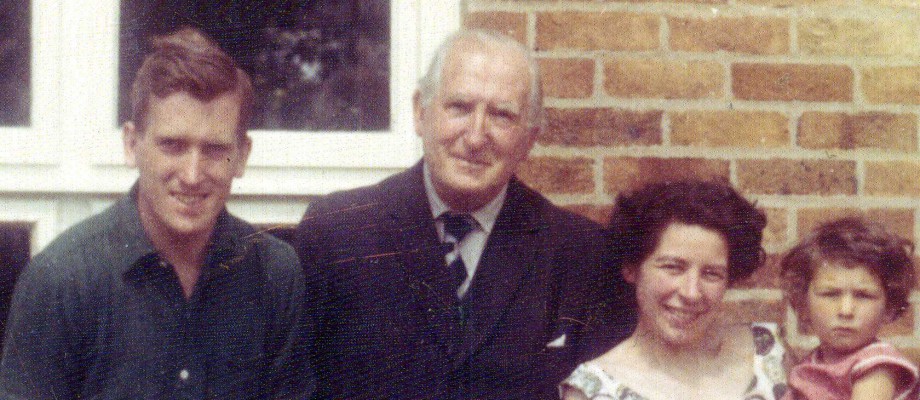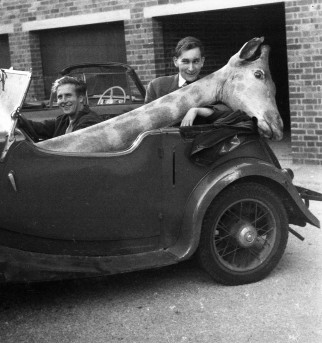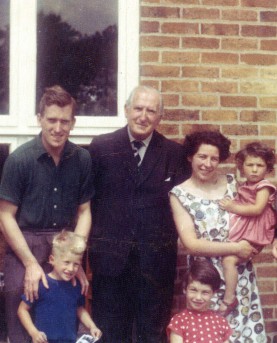
Harold B. Mattingly, 1923–2015
October 21st, 2015
A former academic staff member of the Department of Classics at The University of Nottingham, Harold Mattingly, died on 23 August 2015, at the age of 92. He was first Lecturer in Ancient History 1950-1965, then Reader in Ancient History from 1965-1969, when he left to take up the post of Professor of Ancient History at the University of Leeds.
The international impact of his research is reflected in his obituary in The Guardian. His achievements, especially in the field of Greek Epigraphy, will be celebrated at a conference at the University of Cambridge on Saturday 31 October, timed to coincide with a memorial meeting in his honour later that day.
Harold was born in Finchley in 1923 and educated at Saffron Walden and the Leys School, Cambridge. After wartime service in the Friends Ambulance Unit and demolition work, he took a double first in the Classics Tripos at Gonville and Caius (1946-1948). He subsequently went on to hold a Craven Scholarship (1948-1950), writing a thesis on the Roman Imperial Senate. His subsequent research came to focus on Classical Greece and the Roman Republic and on numismatic and epigraphic problems. His favourite canvas was the academic article, with more than 160 of them produced in multiple typewritten drafts – he never took to word processors or computers. There are three published volumes of collected essays. His father, also named Harold, was another famous ancient historian and numismatist and, though initially in his shadow, the younger Harold soon established his own international reputation. The middle initial B. of the younger Harold (and sometimes the date of publication) is the best way to tell them apart.
Harold’s major scholarly contributions centred on long-running controversies, in which the recurrent pattern was that he adopted a minority view against the prevailing orthodoxy, maintaining his position across decades and in the face of sustained and sometimes harshly expressed and dismissive judgements from senior academics. Unfortunately for his opponents, he had an annoying habit of eventually being proved right. The initial groundwork for his major academic battles was laid down during his Nottingham years. The most important of these debates centred on the dating of a key series of inscriptions relating to Athenian imperialism. The chronology of the shift in Athenian policy towards her allies, becoming increasingly harsh and imperialistic, depended on the dating of a change in letter form from the three- to four-barred sigma used in public inscriptions in the mid to late 5th century BC. Harold’s contention was that the shift in Athenian imperialism fitted best with a date after 425 BC, when Athens was embroiled in the Peloponnesian War, rather than the pre-445 BC period (where orthodoxy placed them). The debate turned on whether a dated text with the more archaic form of three-barred sigma could be found after 445 BC, and Harold’s claim from the 1960s onwards that an inscription recording an alliance between Athens and Egesta should be dated to 418 BC was eventually shown to be correct by the use of photo enhancement and laser imaging in the late 1980s.
In contrast to his reputation as an obstinate and obdurate opponent in these debates, Harold was in fact an extraordinary mild mannered and courteous man, known as a conscientious teacher and encourager of students. Several letters to the family have independently described him as the nicest man the correspondent ever encountered in academia. Professor Stephen Hodkinson of the Department of Classics at Nottingham remembers him in the following terms: “He was enormously generous and helpful to me as a young university lecturer. He was a man whose modesty and humility masked immense intellectual acumen and courage.” Even in retirement he could remember the names of practically every student he had taught in his Nottingham years and was still in regular contact with several of them.
Harold enjoyed a very happy 55-year marriage to the artist Erica, with some of their best years being those in Nottingham. Although she later became a notable potter, during the Nottingham years she was best known as a designer, working on book jackets, posters (we have a substantial collection advertising the annual Wortley Hall plays – of which more below) as well as working on early displays in the University museum. In the mid-1950s they made their home in Wortley Hall Close on the edge of the campus combining starting their family with being part of the Wortley Hall community. With such enigmatic characters as Harry Lucas and ‘Uncle’ Bob Waterhouse as wardens, they and a number of other families in Wortley Hall Close remained lifelong friends. Harold’s contributions to student life as a Wortley tutor included the occasional loan of a stuffed giraffe’s neck and head known as Geraldine (normally her nose was used for storing the hosepipe in the family garage) for various student events. On one such occasion Geraldine was being driven to a party; this necessitated being held in a vertical position in a tiny open top car and caused a bus, going up the Derby Road, to veer dramatically to one side as the upper deck passengers rushed across to the University side, to see what appeared to be a giraffe going at full gallop on the other side of a hedge.
These were days of great change and development for the University – when Harold first walked to his office from Wortley Hall across open fields, there were still farm animals on the loose, including obstreperous geese that chased him home on more than one occasion. In a relaxed age of parenting, their children, Jo, David and Liz, were largely allowed the run of the campus, earning the epithet of ‘the free range Mattinglys’. Harold was often sent out at twilight with the family dog, Sam, to call them home.
Visiting children at birthday parties enjoyed treasure hunts taking in Wortley landmarks such as the flagpole, dove cot, summer house, perched on top of ‘the jungle’ and the hedgehog pens. The highlight would be Harold’s conjuring show and although his sleight of hand became less subtle with age, the sight of the soft white fluffy (glove puppet) rabbit was magical and continued to entertain his five grandchildren in later years.
Bonfire nights brought the whole Wortley community together, building a huge bonfire in the field behind the Close, always with a guy on top, though in a pre health and safety era the firework storage and lighting by Harold and other academics was somewhat haphazard, though thankfully uneventful. The Cripps fete was an annually awaited treat, particularly the bowling for a pig, as Liz loved pigs! Harold and Erica must have breathed a sigh of relief when their children came second by the proverbial pig’s whisker one year. It has to be said that by this time all the surrounding farms had long gone and the houses in the close had very small tidy gardens!
Harold was also closely involved with the development of Nottingham Playhouse and his theatrical interests extended to co-producing the annual Wortley Hall plays. Most memorable was the Teahouse of the August Moon, when he made the classic error of allowing roles for his children and a bad tempered billy goat, who did not take kindly to being kept in a neighbour’s garage for the duration and charged the door every morning when Harold was sent in to feed it!
His wide range of other activities included art, politics, concerts, punting, Quakerism, human rights charities, conjuring, football and cricket. He loved cricket above all games and was an enthusiastic fielder for the university staff team, though he accumulated few runs and never took a wicket. He attended Test Matches for nearly 80 years and was a great talker of the finer points of the game.
Harold and Erica settled in Cambridge after his retirement from Leeds in 1987 – he continuing to research and write and she to pot. He was a fixture in the Classics Faculty library in Cambridge up to his 90th birthday and received a copy of his final publication just days before he died. Erica’s death in 2008 affected Harold greatly, but he managed to maintain his independence and extraordinary sense of humour with live-in carers and family support at weekends. Having served as President of the Royal Numismatic Society from 1999-2004, he was still making adventurous forays to its meetings in London as late as 2013, often with logistical support from his grandchildren. Despite increasing infirmity, he also continued to be an indomitable foreign traveller with trips in his last years to Greece, Rome, St Petersburg and Burgundy. A short book of his memories of travels in Greece was produced with illustrations by his daughter Jo, who had accompanied him on his last trips. As well as his children and their spouses Alex, Jenny and Bill, Harold loved the company of his five grandchildren, Rebecca, Susanna, Louisa, Douglas and Isabelle.
Comments are closed.
Other

Need news? See you on SharePoint
After 14 years of service, Campus News is being retired as the university’s staff news platform. […]

Roads and car parks closed for refurbishing work
As part of ongoing road improvements at the university, works will be taking place to resurface […]



